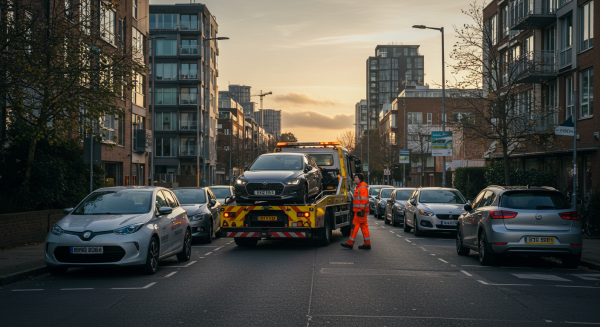Recovery operators face unique challenges when attending to broken-down vehicles in areas with restricted access, such as Clean Air Zones (CAZs), Low Traffic Neighbourhoods (LTNs), and bus lanes. This article explores the rules and exemptions that apply to recovery vehicles in these situations.
Clean Air Zones
Recovery vehicles responding to breakdowns within Clean Air Zones benefit from some exemptions. According to current government guidance, vehicles that meet the definition of a “recovery vehicle” under the Vehicle Excise and Registration Act 1994 are granted national exemptions from CAZ charges. To qualify, the vehicle must be constructed or permanently adapted primarily for lifting, towing, and transporting disabled vehicles.
However, recovery operators should note that these exemptions only apply when the vehicle is being used for legitimate recovery purposes, such as:
- Recovering a broken-down vehicle
- Moving a broken-down vehicle to repair premises
- Moving a vehicle between repair premises
- Responding to police or local authority requests to remove vehicles
Bus Lanes
The rules around recovery vehicles using bus lanes are less straightforward. While buses, cycles, and, in many cases, taxis can use bus lanes by default, local authorities have discretion over whether to permit recovery vehicles to use them. This can create challenges when attending breakdowns that occur in or require access via bus lanes.

Recovery operators should:
- Check local regulations, as permissions vary between authorities.
- Only use bus lanes when explicitly permitted or when no alternative route exists to reach a broken-down vehicle.
- Keep documentary evidence of the legitimate recovery purpose of their journey.

Low Traffic Neighbourhoods
When attending breakdowns within LTNs, recovery operators need to be aware of access restrictions and any exemption processes. While emergency vehicles typically have exemptions to access LTNs, recovery vehicles may need to:
- Apply for permits in advance.
- Use designated access points.
- Keep records demonstrating legitimate recovery purposes.
- Follow any specific local authority guidance.
Good Practice for Operators
To manage restricted access recoveries effectively, operators should:
- Maintain clear documentation of legitimate recovery purposes.
- Keep up to date with local regulations and exemptions.
- Plan routes carefully, considering access restrictions.
- Build relationships with local authorities to understand requirements.
- Train drivers on correct procedures for restricted areas.
Recovery operators should remember that while exemptions exist to facilitate essential recovery work, these should not be abused or used when alternative routes are available. Maintaining professional standards helps protect continued access to restricted areas when genuinely needed.
Note: Rules and exemptions can vary significantly between local authorities. Recovery operators should always check current local regulations for specific guidance.
The article is written based on synthesising information from government guidance on Clean Air Zones and special vehicle types from the provided source documents. As rules can change and vary by location, operators should verify current requirements for their specific area of operation.
